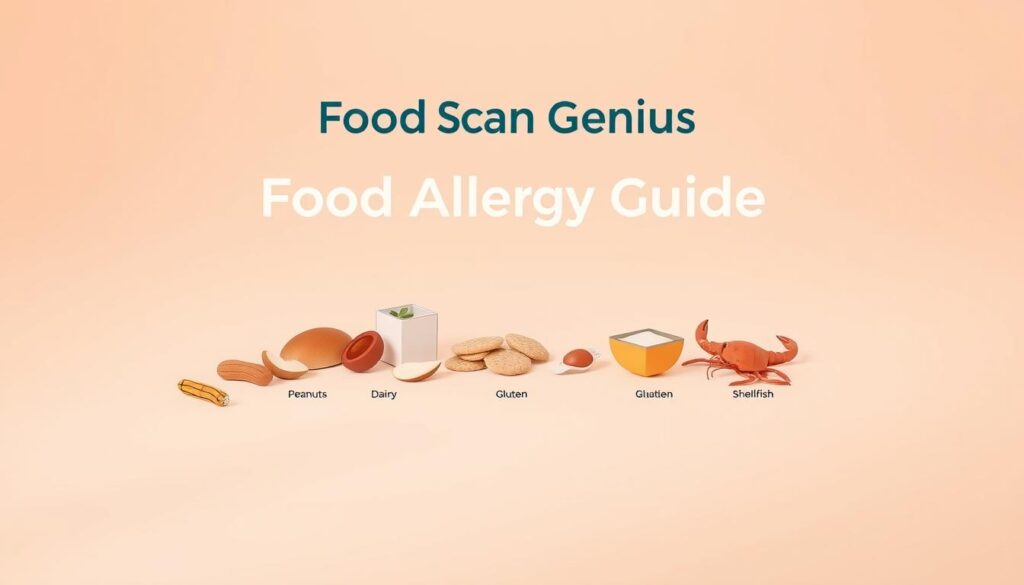Have you ever felt overwhelmed while reading food labels? You’re not alone. For millions of Americans, navigating grocery aisles can feel like a minefield. Food allergies are more common than ever, and knowing what to look for is essential for staying safe.
Whether it’s milk, eggs, peanuts, or sesame, these common allergens can hide in unexpected places. That’s why we’re here to help. This guide is designed to make understanding food allergies simple, clear, and even a little fun!
We’ll walk you through the basics, explain why this matters, and introduce you to tools like the Food Scan Genius app. It’s the ultimate AI assistant for shoppers with food allergies, available for both iOS and Android. Let’s make grocery shopping safer and stress-free together!
Key Takeaways
- Food allergies affect millions of people, making label reading essential.
- Common allergens include milk, eggs, peanuts, and sesame.
- The FDA requires clear labeling of major allergens on food products.
- The Food Scan Genius app helps you shop smarter and safer.
- Understanding food allergies can make grocery shopping less stressful.
Introduction to Allergens in Packaged Foods
Ever wondered why some foods trigger unexpected reactions? For millions of people, eating the wrong thing can lead to anything from a mild itch to a life-threatening situation. Food allergies are more common than you might think, and understanding them is the first step to staying safe.
An Overview of Food Allergies
When your body mistakes a harmless food product as a threat, it launches an immune response. This is what we call an allergic reaction. Symptoms can range from mild—like a rash or stomachache—to severe, such as difficulty breathing or anaphylaxis. Knowing the difference is crucial.
Common signs of a reaction include hives, swelling, or tingling in the mouth. In more serious cases, symptoms like dizziness or trouble breathing require immediate attention. It’s not just about avoiding certain foods—it’s about understanding how your body reacts to them.
The Importance of Allergen Awareness for Shoppers
Reading labels isn’t just a good habit—it’s a necessity. Even a tiny trace of an allergen can cause a reaction. That’s why being aware of what’s in your food is so important. Always check ingredient lists, even for products you’ve bought before. Recipes can change, and so can your safety.
We’re here to make this easier for you. By learning about allergens and how they affect you, you can shop smarter and feel more confident in your choices. Let’s take this journey together—because your health is worth it!
Key Regulations and Guidelines on Food Allergens
Understanding food regulations doesn’t have to be confusing. We’re here to break it down in a way that feels like a chat with a friend. The FDA and other agencies have put rules in place to keep you safe, and we’ll walk you through what they mean for your everyday shopping.
FDA and FALCPA Requirements
Back in 2004, the FDA introduced the Food Allergen Labeling and Consumer Protection Act (FALCPA). This law requires manufacturers to clearly list major allergens like milk, egg, peanut, and tree nut on labels. It’s a game-changer for anyone with food sensitivities.
FALCPA covers over 90% of documented allergies in the U.S. It applies to most packaged items, including vitamins and dietary supplements. However, fresh produce and highly refined oils are exempt. Always check the label—even if you’ve bought the product before. Recipes can change!
Labeling Standards and the FASTER Act
In 2021, the FASTER Act added sesame to the list of major allergens. This update ensures even more transparency for shoppers. The FDA also works closely with manufacturers to ensure compliance, especially after findings like non-compliant “dairy-free” products containing milk.
Here’s a quick summary of key labeling rules:
| Allergen | Labeling Requirement |
|---|---|
| Milk | Must be listed in plain English |
| Egg | Must be listed in plain English |
| Peanut | Must be listed in plain English |
| Tree Nut | Must specify the type (e.g., almond, walnut) |
| Sesame | Added in 2021 under the FASTER Act |
These rules are here to protect you. By understanding them, you can shop with confidence and peace of mind. Let’s make food safety simple—because you deserve it!
Understanding Top Allergens in Packaged Foods
Do you know what’s really hiding in your favorite snacks? It’s not just about taste—it’s about safety. Many common items, like wheat and sesame, can sneak into foods you’d never suspect. Let’s break it down so you can shop smarter.
Proteins are often the culprits behind allergic reactions. For example, the protein in wheat can trigger symptoms in sensitive individuals. Manufacturers are required to list these ingredients clearly on the label, but it’s not always straightforward.
Here’s the thing: a direct ingredient listing is different from a “may contain” warning. The first means the allergen is definitely there. The second means it could be present due to shared equipment or facilities. Both are important to watch for.
Let’s look at a real example. A granola bar might list wheat as an ingredient but also include a “may contain tree nuts” warning. This tells you there’s a risk of cross-contact, even if nuts aren’t a main ingredient.
By understanding these details, you can make safer choices. Whether it’s sesame in your sandwich bread or wheat in your cereal, being informed puts you in control. Let’s make label reading less of a chore and more of a superpower!
Common Food Allergies and Their Impact
Did you know that food allergies affect millions of Americans every day? Roughly 33 million people in the U.S. experience these conditions, with symptoms ranging from mild discomfort to life-threatening reactions. Let’s dive into the trends and how they impact different age groups.
Allergy Trends in the United States
Food allergies are on the rise, and certain items are more likely to trigger reactions. For example, peanuts, tree nuts, and shellfish are among the most common culprits. According to the FDA, these account for a significant portion of allergic responses.
Interestingly, some allergies are more prevalent in children. Milk and egg allergies, for instance, often appear early in life. The good news? Many kids outgrow these by their teenage years. However, peanut and tree nut allergies tend to stick around.
Impact on Different Age Groups
Age plays a big role in how allergies manifest. Kids might react to milk or eggs, while adults often develop sensitivities to shellfish or tree nuts. It’s a reminder that allergies can pop up at any stage of life.
Severe reactions, like anaphylaxis, require immediate attention. Symptoms can escalate quickly, making prompt treatment essential. Epinephrine auto-injectors are a lifesaver in these situations—literally.
Thankfully, advancements in drug therapies are making it easier to manage these conditions. From antihistamines to immunotherapy, there are more options than ever to help you stay safe and confident.
Whether you’re a parent navigating your child’s allergies or an adult managing your own, understanding these trends can make a world of difference. Let’s tackle this together—because you’re not alone in this journey!
Symptoms and Risks of Food Allergies
What’s the first thing you notice when an allergic reaction starts? For many, it’s a sudden itch or swelling. Symptoms can appear in minutes, and knowing what to look for could save a life. Let’s break it down so you’re prepared.
Recognizing Reaction Symptoms
Allergic reactions can vary, but some signs are more common than others. Here’s what to watch for:
- Skin reactions: Hives, redness, or itching are often the first clues.
- Swelling: Lips, face, or throat swelling can happen quickly.
- Breathing difficulties: Wheezing or shortness of breath is a serious sign.
According to research, symptoms can start within minutes of exposure. A report from the FDA highlights that even a tiny amount of an allergen can trigger a reaction. That’s why it’s so important to act fast.
Emergency Situations and Anaphylaxis
Anaphylaxis is the most severe form of allergic reaction. It can be life-threatening if not treated immediately. Symptoms include:
- A sudden drop in blood pressure.
- Rapid heartbeat or weak pulse.
- Loss of consciousness.
In cases like these, every second counts. A January report emphasizes that prompt use of an epinephrine auto-injector is the best way to manage anaphylaxis. Always seek medical help right away.
Understanding your critical date—or timeline—for intervention is key. Whether it’s a mild reaction or a full-blown emergency, knowing the signs can make all the difference. Let’s stay informed and safe together!
Practical Tips for Safe Food Shopping
Navigating the grocery store can feel like a puzzle, especially when you’re trying to avoid certain ingredients. We’re here to make it simpler with some practical tips that can help you shop with confidence and reduce your risk of exposure to hidden allergens.

How to Identify Hidden Allergens
Reading labels carefully is your first line of defense. Always check the ingredient list, even for products you’ve bought before. Recipes can change, and so can your safety. Look for clear allergen statements like “Contains” or “May contain” warnings.
Here’s a quick guide to help you spot potential risks:
| Label Statement | What It Means |
|---|---|
| Contains [Allergen] | The allergen is definitely in the product. |
| May Contain [Allergen] | Cross-contact is possible during manufacturing. |
| Produced in a Facility That Processes [Allergen] | Shared equipment or facilities increase risk. |
Taking the time to read labels can protect your skin and lips from reactions. It’s a small step that makes a big difference in your safety.
Another tip is to shop during less busy times. Fewer people mean less chance of cross-contact from shared shopping carts or handling products. Plus, you’ll have more time to focus on reading labels without feeling rushed.
Finally, consider using apps like Food Scan Genius. It’s a handy tool that helps you quickly check products for allergens, making your shopping experience smoother and safer.
By following these tips, you can reduce your risk and shop with peace of mind. Let’s make grocery shopping a safer, more enjoyable experience together!
Reading and Interpreting Food Labels
Ever paused to decode the tiny print on food labels? It’s not just about ingredients—it’s about safety. Those “may contain” warnings are there for a reason, and understanding them can make all the difference for your health.
Understanding “May Contain” Statements
When you see “may contain” on a label, it’s a heads-up about potential cross-contact. This means the product could have traces of allergens like shellfish or fish due to shared equipment or facilities. It’s not an ingredient, but it’s still a risk.
Here’s why these warnings matter: even a tiny trace can trigger an adverse reaction. For example, a cookie might not list shellfish as an ingredient, but if it’s made in a facility that processes shrimp, the risk is real. That’s why reading labels carefully is non-negotiable.
Let’s break it down with a quick guide:
- “Contains”: The allergen is definitely in the product.
- “May contain”: Cross-contact is possible during manufacturing.
- “Produced in a facility that processes”: Shared equipment increases the risk.
Another tip? Check the number of allergens listed. The more warnings, the higher the risk. For instance, a product with multiple “may contain” statements for fish, shellfish, and nuts might not be the safest choice if you’re sensitive to any of these.
We’re here to make label reading less overwhelming. By understanding these warnings, you can shop smarter and stay safe. Remember, it’s not just about what’s in the product—it’s about what could be there too. Let’s decode those labels together!
The Role of Technology in Managing Food Allergies
Imagine having a personal assistant in the grocery aisle, making sure every item you pick is safe for your family. Thanks to advancements in technology, this is now a reality. We’re here to show you how tools like the Food Scan Genius app can transform your shopping experience, making it safer and stress-free.

Download the Food Scan Genius App
Ready to take control of your food safety? The Food Scan Genius app is your ultimate ally. Available for both iOS and Android, this app is designed to help you navigate the grocery store with confidence. Here’s how to get started:
- Download the app from https://food.scangeni.us.
- Set up your profile with your specific dietary needs and allergic food sensitivities.
- Scan product barcodes to instantly check for allergens like soybean or other triggers.
It’s that simple! With just a few taps, you’ll know if a product is safe for you or your family.
How AI Enhances Food Allergy Safety
Artificial intelligence is revolutionizing the way we manage food allergies. The Food Scan Genius app uses cutting-edge AI to analyze “may contain” statements and ingredient lists, giving you instant, accurate results. Here’s what makes it stand out:
| Feature | Benefit |
|---|---|
| Instant Allergen Detection | Quickly identifies unsafe ingredients. |
| Personalized Recommendations | Suggests safe alternatives based on your profile. |
| Cross-Contact Alerts | Warns about potential risks from shared equipment. |
As one user put it, “This app is like having a food safety expert in my pocket!”
Whether you’re avoidingsoybeanor other allergens, this tool ensures you’re always one step ahead.
Technology isn’t just a convenience—it’s a game-changer for anyone managing allergic food sensitivities. Let’s embrace it together and make grocery shopping a breeze!
Conclusion
Managing sensitivities can feel tricky, but it doesn’t have to be. We’ve walked through the essentials—from smarter labeling to safe shopping practices. Real-life examples show how these steps can make a big difference for any person dealing with dietary challenges.
Staying informed is key. Whether it’s understanding FDA regulations or using tools like the Food Scan Genius app, you’re taking control of your health. For cases like avoiding soy or other triggers, technology can be a game-changer.
Ready to make grocery shopping safer and simpler? Download the Food Scan Genius app today and join our supportive community. Together, we can turn challenges into confidence—one label at a time!
FAQ
What are the most common food allergens in packaged foods?
The most common food allergens include milk, egg, peanut, tree nut, wheat, soy, fish, and shellfish. These are often referred to as the “Big 8” and are required to be clearly labeled on food products in the U.S.
How can I identify allergens on food labels?
Look for allergen statements like “Contains” followed by the allergen name. Also, check for “may contain” warnings, which indicate potential cross-contamination during manufacturing.
What should I do if I have an allergic reaction to food?
Seek medical attention immediately, especially if symptoms like swelling, difficulty breathing, or dizziness occur. Always carry an epinephrine auto-injector if prescribed by your doctor.
Are there new regulations for labeling allergens like sesame?
Yes! The FASTER Act, effective January 2023, added sesame as the 9th major allergen, requiring clear labeling on packaged foods in the U.S.
Can food allergies develop later in life?
Absolutely. While many allergies appear in childhood, adults can develop new allergies to foods like shellfish, tree nuts, or even soy.
How can technology help manage food allergies?
Apps like Food Scan Genius use AI to scan barcodes and identify allergens in products, making grocery shopping safer and easier for those with allergies.
What’s the difference between a food allergy and intolerance?
A food allergy involves the immune system and can cause severe reactions, while an intolerance typically leads to digestive discomfort and isn’t life-threatening.
Are there any treatments for food allergies?
While there’s no cure, treatments like oral immunotherapy (OIT) can help desensitize individuals to certain allergens. Always consult an allergist for personalized advice.
How can I avoid cross-contamination at home?
Use separate utensils, cutting boards, and cookware for allergen-free meals. Clean surfaces thoroughly and store allergen-free foods separately.
What’s the best way to handle dining out with food allergies?
Always inform the staff about your allergies, ask about ingredient lists, and choose restaurants with allergy-friendly menus. Apps like AllergyEats can also help find safe dining options.





